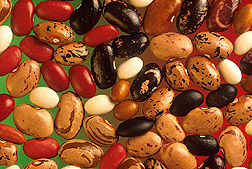This page has been archived and is being provided for reference purposes only. The page is no longer being updated, and therefore, links on the page may be invalid.
Researchers Continue to Improve Red Bean QualityBy Don ComisJanuary 30, 2002 An Agricultural Research Service and Michigan State University breeding team is seeing red lately--when it comes to beans. Each year, the team releases two to four new dry bean varieties. Recently, the scientists have released small red bean types that, until now, have received little attention. Geneticist and breeder George L. Hosfield at the ARS Sugarbeet and Bean Research Unit's Quality Laboratory in East Lansing, Mich., and colleagues at the Michigan Agricultural Experiment Station have developed a unique pool of new red bean lines. The lines contain genes for improved erectness, disease resistance, seed appearance and canning quality. From this breeding material came LeBaron Red, a variety far ahead of traditional ones for uprightness and seed appearance. The new lines are so good that, from now on, breeders will use only them for breeding red beans. And recently, the team released even better germplasm in three more breeding lines of red beans. For the last quarter century, Hosfield has been the only scientist in the country working on bean quality--upgrading the color, canning quality and other characteristics of dry beans as well as their nutritional value. A few years ago, he decided to make red beans his priority. Smaller than kidney beans and shaped more like pintos, 90 percent of red beans come from Washington and Idaho. They are typically used in chili products and mixes. Like LeBaron, the new lines all have resistance to bean common mosaic virus, a major bean disease. One of the lines also has resistance to several strains of bean rust, a major fungal disease. The new lines have improved yield. The germplasm will be deposited in the ARS National Plant Germplasm System where it will be available free to researchers and breeders for development and commercialization of other red bean varieties that will take their places alongside the pioneering LeBaron. ARS is USDA’s chief scientific research agency. |

